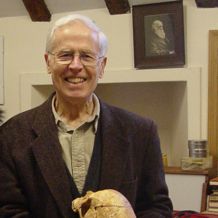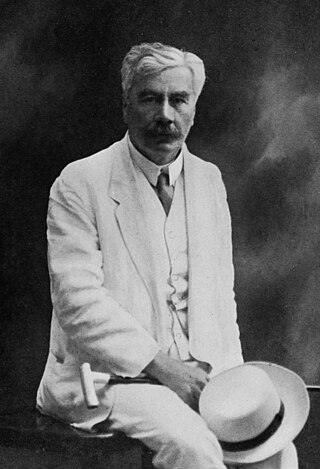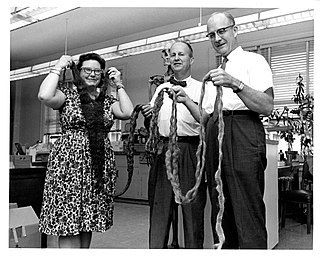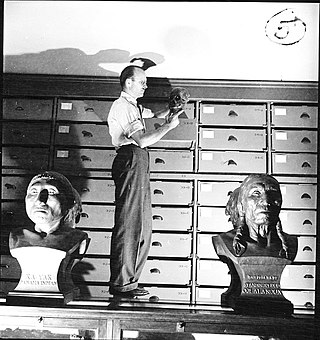Bioarchaeology in Europe describes the study of biological remains from archaeological sites. In the United States it is the scientific study of human remains from archaeological sites.

Paleopathology, also spelled palaeopathology, is the study of ancient diseases and injuries in organisms through the examination of fossils, mummified tissue, skeletal remains, and analysis of coprolites. Specific sources in the study of ancient human diseases may include early documents, illustrations from early books, painting and sculpture from the past. All these objects provide information on the evolution of diseases as well as how past civilizations treated conditions. Studies have historically focused on humans, although there is no evidence that humans are more prone to pathologies than any other animal.

Jane Ellen Buikstra is an American anthropologist and bioarchaeologist. Her 1977 article on the biological dimensions of archaeology coined and defined the field of bioarchaeology in the US as the application of biological anthropological methods to the study of archaeological problems. Throughout her career, she has authored over 20 books and 150 articles. Buikstra's current research focuses on an analysis of the Phaleron cemetery near Athens, Greece.

Donald Reginald Brothwell, was a British archaeologist, anthropologist and academic, who specialised in human palaeoecology and environmental archaeology. He had worked at the University of Cambridge, the British Museum, and the Institute of Archaeology of University of London, before ending his career as Professor of Human Palaeoecology at the University of York. He has been described as "one of the pioneers in the field of archaeological science".

Alice May Roberts is an English academic, TV presenter and author. Since 2012 she has been Professor of Public Engagement in Science at the University of Birmingham. She was president of the charity Humanists UK between January 2019 and May 2022. She is now a vice-president of the organisation.

Sir Marc Armand Ruffer CMG was a France-born British experimental pathologist and bacteriologist. He is considered a pioneer of modern paleopathology.

John Lawrence Angel (1915–1986) was a British-American biological anthropologist born on 21 March 1915 in London. His writings have had the biggest impact on paleodemography.
Helena Francisca Hamerow, is an American archaeologist, best known for her work on the archeology of early medieval communities in Northwestern Europe. She is Professor of Early Medieval archaeology and former Head of the School of Archaeology, University of Oxford.
George J. Armelagos was an American anthropologist, and Goodrich C. White Professor of Anthropology at Emory University in Atlanta, Georgia. Armelagos significantly impacted the field of physical anthropology and biological anthropology. His work has provided invaluable contributions to the theoretical and methodological understanding human disease, diet and human variation within an evolutionary context. Relevant topics include epidemiology, paleopathology, paleodemography, bioarchaeology, evolutionary medicine, and the social interpretations of race, among others.

Dame Rosemary Jean Cramp, was a British archaeologist and academic specialising in the Anglo-Saxons. She was the first female professor appointed at Durham University and was Professor of Archaeology from 1971 to 1990. She served as president of the Society of Antiquaries of London from 2001 to 2004.

Thomas Dale Stewart was a founder of modern forensic anthropology and a major contributor to most areas of human skeletal biology, paleopathology, and related areas of physical anthropology.

Medieval bioarchaeology is the study of human remains recovered from medieval archaeological sites. Bioarchaeology aims to understand populations through the analysis of human skeletal remains and this application of bioarchaeology specifically aims to understand medieval populations. There is an interest in the Medieval Period when it comes to bioarchaeology, because of how differently people lived back then as opposed to now, in regards to not only their everyday life, but during times of war and famine as well. The biology and behavior of those that lived in the Medieval Period can be analyzed by understanding their health and lifestyle choices.
Kathryn Hunt is an American archaeologist and paleopathologist specializing in paleo-oncology, the multidisciplinary study of cancer in human history.
Mortuary archaeology is the study of human remains in their archaeological context. This is a known sub-field of bioarchaeology, which is a field that focuses on gathering important information based on the skeleton of an individual. Bioarchaeology stems from the practice of human osteology which is the anatomical study of skeletal remains. Mortuary archaeology, as well as the overarching field it resides in, aims to generate an understanding of disease, migration, health, nutrition, gender, status, and kinship among past populations. Ultimately, these topics help to produce a picture of the daily lives of past individuals. Mortuary archaeologists draw upon the humanities, as well as social and hard sciences to have a full understanding of the individual.
Mary Lewis is Professor of Bioarchaeology at the University of Reading. After completing a PhD in bioarchaeology at the University of Bradford in 1999, Lewis went on to lecture at Bournemouth University (2000–2004) before moving to the University of Reading in 2004. She conducted the first osteological study of a body which has been hanged, drawn, and quartered. Lewis has held editorial roles with the International Journal of Osteoarchaeology, International Journal of Paleopathology, and the American Journal of Biological Anthropology.
Rebecca Gowland is a bioarchaeologist. She is a Professor of Archaeology at Durham University.
Sonia Ruth Zakrzewski is a bioarchaeologist and associate professor at the University of Southampton.

Lucile Eleanor St. Hoyme was an American biological anthropologist who conducted research related to human variation, bioarcheology, and paleopathology. St. Hoyme served as an Assistant Curator in the Department of Anthropology at the National Museum of Natural History. St. Hoyme analyzed human remains excavated from the John Kerr Reservoir Basin using a new bioarcheological approach combining data from other disciplines. Beyond her work with the Smithsonian collections, St. Hoyme also worked on FBI forensic cases in the 1960s with National Museum of Natural History Anthropology Curator J. Lawrence Angel.
Tony Waldron was a British physician and bioarchaeologist specialising in occupational medicine, palaeopathology, and palaeoepidemiology. He was an honorary professor at the UCL Institute of Archaeology, a lecturer in occupational medicine at the London School of Hygiene & Tropical Medicine, and a consultant physician at University College Hospital and St Mary's Hospital. He wrote a number of books on bioarchaeology, including the widely used textbooks Palaeoepidemiology (2007) and Palaeopathology (2009).
Deborah C. Merrett is a Canadian anthropologist and paleopathologist known for her contributions to the study of ancient human health and the biological responses of early populations to environmental challenges. She has worked extensively on bioarchaeology and paleopathology, specifically focusing on the analysis of health patterns in ancient populations. Merrett’s research spans several early human settlements, with notable work at the sites of Ganj Dareh, Iran, and the Late Shang site of Yinxu, China.










